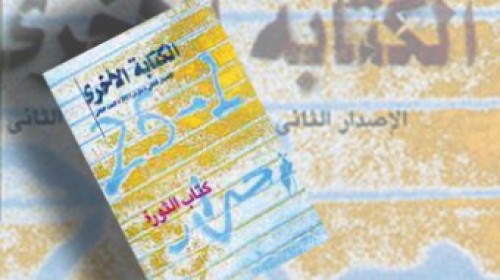The Book of the Revolution: Tunisian Signs
by Hamdy El-Gazzar and translated by Nour Abdelghani / March 11, 2013 / No comments
An Egyptian magazine pays tribute to the Tunisian Revolution’s impact on the region.
“If, one day, a people desires to live,
Then fate will answer their call.
And their night will then begin to fade
And their chains break and fall.”
Perhaps this stanza, written over 80 years ago by the Tunisian poet Abi Qasim Al-Shabi, is the most famous verse to be recited by protesters in the squares and streets that are home to revolutions across the Middle East. Those streets and squares in Egypt, Libya, Syria, and Tunisia. Tunisia, after all, is home to both the region’s revolutions and Al-Shabi’s poem. It was the first spark, the fire, the trigger that inspired the Egyptians and Libyans.

- “From Egypt” attempts to draw a cultural map of Egypt and the Arab world by profiling the artistic, literary, and political issues that affect the region via on-the-ground coverage of current events, publications, and the fight for freedom of expression.

- Hamdy El-Gazzar is an Egyptian writer and one of the 39 young Arab writers included in the Beirut 39 Project. His first novel, Sihr Aswad (Dar Merit, 2005) won the prestigious Sawaris Award, and was subsequently translated by Humphrey Davies (Black Magic, AUC Press, 2007). His second novel, Ladhdhat Sirriyya (Secret Pleasures) was published by Dar al-Dar in 2008. He is currently working on a third novel.
In March of 2011, the first attempt to chronicle the first 18 days of the Egyptian Revolution in book form appeared in Cairo. Other Writings, an independent non-partisan publication, also put out a special issue titled “Book of the Revolution” which contained documents, articles, literary texts, and folders of photographs and cartoons from the revolution.
After that issue the magazine moved its focus from the revolution in Egypt and changed into its current form, “Tunisian Signs,” to chronicle the events in Tunis; it also opened its pages to Tunisian writers, artists, and intellectuals.
In the introduction to that issue, Hesham Keshta, the Editor-in-Chief of Other Writings, expresses his vision for the Egyptian Revolution. As an intellectual and educator he explains his take on issues of social justice, dignity, and freedom in the country. He also urges Egyptians to come closer to Tunisian culture, the culture that awoke in us the dream of a better future, and ensured our capability to carve the image we have of that future. Finally, Keshta implores us to come closer to a country whose people have achieved countless successes in women’s rights, unions, and modernized education. Such changes are the pillars people rely on to complete the revolution. Additionally, these pillars enable us, as Arabs, to rid our minds of the blindfolds that have affected our growth for centuries.
The issue deals with the Tunisian Revolution from different angles and contains a large number of Tunisian political cartoons and revolution-based art.
All in all, the large anthology symbolizes the grandness of the Tunisian Revolution and its intellectuals and artists. The cover art features the Egyptian artist, Ahmed Alabad. It is a serious and important publication that deserves to be read and admired.





